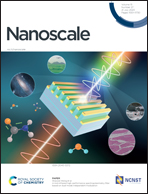Spinodal decomposition introduces strain-enhanced thermochromism in polycrystalline V1−xTixO2 thin films†
Abstract
Processes of self-organization play a key role in the development of innovative functional nanocomposites, allowing, in particular, the transformation of metastable solid solutions into multilayers by activating spinodal decomposition instead of layer-by-layer film growth. We report the formation of strained layered (V,Ti)O2 nanocomposites in thin polycrystalline films using a spinodal decomposition. Already during the growth of V0.65Ti0.35O2 films, spinodal decomposition was detected while producing atomic-scale disordered V- and Ti-rich phases. Post-growth annealing enhances compositional modulation, arranges the local atomic structures of the phases, and yields periodically layered nanostructures that resemble superlattices. The coherent interfacing of the V- and Ti-rich layers results in the compression of the V-rich phase along the c-axis of the rutile structure and enables strain-enhanced thermochromism. The latter is characterized by a simultaneous decrease in the temperature and width of the metal–insulator transition in the V-rich phase. Our results provide proof-of-concept for an alternative strategy to develop VO2-based thermochromic coatings by introducing strain-enhanced thermochromism into polycrystalline thin films.



 Please wait while we load your content...
Please wait while we load your content...